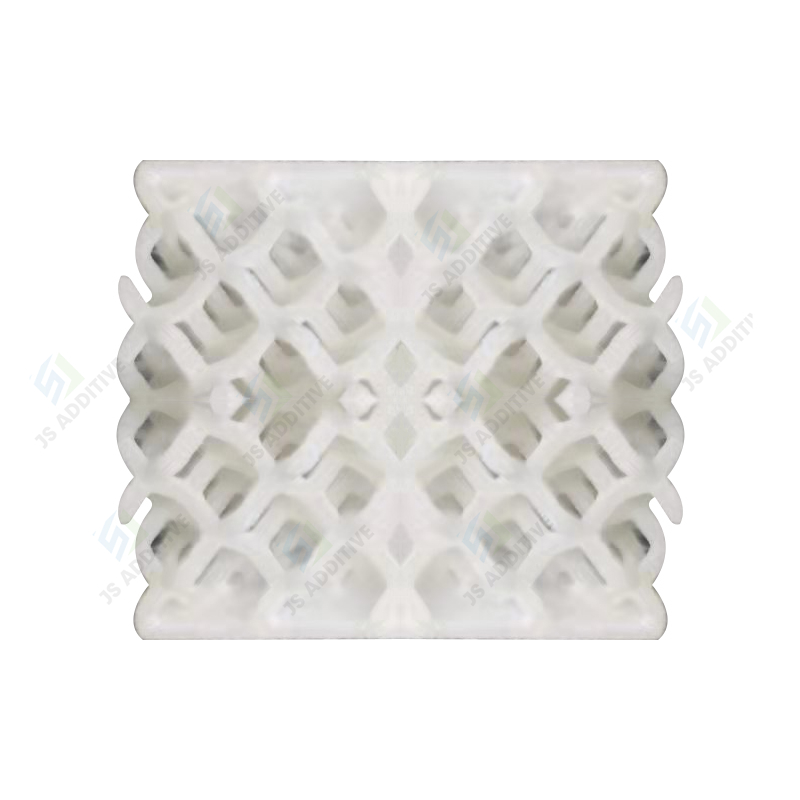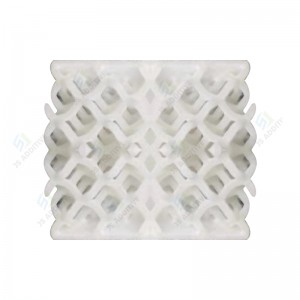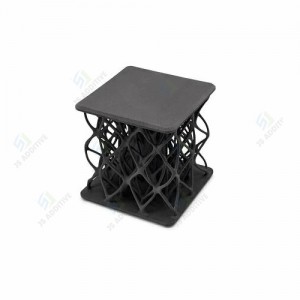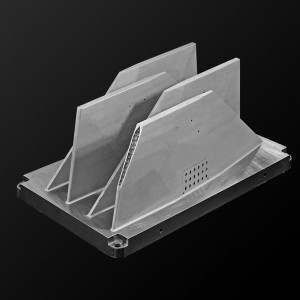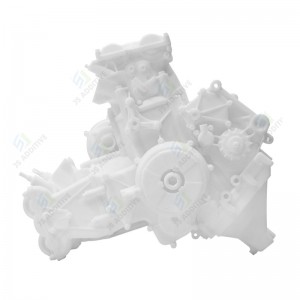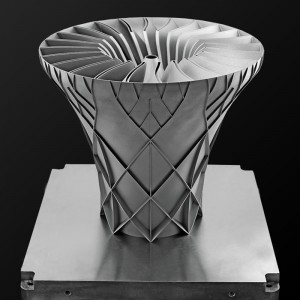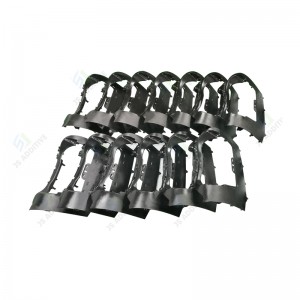Basic Properties
| Item | Value | Remarks | ||
| Product | 8400 | 8400N | ||
| Appearance | A Comp. | Black | Clear,colorless | Polyol(Freezes below 15°C) |
| B Comp. | Clear, pale yellow | Isocyanate | ||
| C Comp. | Clear, pale yellow | Polyol | ||
| Color of article | Black | Milky white | Standard color is black | |
| Viscosity (mPa.s 25°C) | A Comp. | 630 | 600 | Viscometer Type BM |
| B Comp. | 40 | |||
| C Comp. | 1100 | |||
| Specific gravity(25°C) | A Comp. | 1.11 | Standard Hydrometer | |
| B Comp. | 1.17 | |||
| C Comp. | 0.98 | |||
| Pot life | 25°C | 6min. | Resin 100g | |
| 6min. | Resin 300g | |||
| 35°C | 3min. | Resin 100g | ||
Remarks:A component freezes at temperatures below 15°C. Melt by heating and use after shaking it well.
3.Basic physical properties ≪A90 ・ A80 ・ A70 ・ A60≫
| Mixing ratio | A:B:C | 100:100:0 | 100:100:50 | 100:100:100 | 100:100:150 |
| Hardness | Type A | 90 | 80 | 70 | 60 |
| Tensile strength | MPa | 18 | 14 | 8.0 | 7.0 |
| Elongation | % | 200 | 240 | 260 | 280 |
| Tear strength | N/mm | 70 | 60 | 40 | 30 |
| Rebound Elasticity | % | 50 | 52 | 56 | 56 |
| Shrinkage | % | 0.6 | 0.5 | 0.5 | 0.4 |
| Density of final product | g/cm3 | 1.13 | 1.10 | 1.08 | 1.07 |
4.Basic physical properties ≪A50 ・ A40 ・ A30 ・ A20≫
| Mixing ratio | A:B:C | 100:100:200 | 100:100:300 | 100:100:400 | 100:100:500 |
| Hardness | Type A | 50 | 40 | 30 | 20 |
| Tensile strength | MPa | 5.0 | 2.5 | 2.0 | 1.5 |
| Elongation | % | 300 | 310 | 370 | 490 |
| Tear strength | N/mm | 20 | 13 | 10 | 7.0 |
| Rebound Elasticity | % | 60 | 63 | 58 | 55 |
| Shrinkage | % | 0.4 | 0.4 | 0.4 | 0.4 |
| Density of final product | g/cm3 | 1.06 | 1.05 | 1.04 | 1.03 |
5.Basic physical properties ≪A10≫
| Mixing ratio | A:B:C | 100:100:650 |
| Hardness | Type A | 10 |
| Tensile strength | MPa | 0.9 |
| Elongation | % | 430 |
| Tear strength | N/mm | 4.6 |
| Shrinkage | % | 0.4 |
| Density of final product | g/cm3 | 1.02 |
Remarks: Mechanical properties:JIS K-7213. Shrinkage:Inhouse specification.
Curing condition: Mold temperature:600C 600C x 60 min.+ 60°C x 24hrs. + 250C x 24 hrs.
Physical properties listed above are typical values measured in our laboratory and not the values for specification. When using our product, it must be noted that physical properties of final product may differ depending on the contour of article and the molding condition.
6. Resistance against heat, hot water and oil ≪A90 ・ A50 ・ A30≫
(1) Heat resistance【kept in 80°C thermostatic oven with circulating warm air
|
A90 |
Item | Unit | Blank | 100 hrs | 200 hrs | 500 hrs |
| Hardness | Type A | 88 | 86 | 87 | 86 | |
| Tensile strength | MPa | 18 | 21 | 14 | 12 | |
| Elongation | % | 220 | 240 | 200 | 110 | |
| Tear resistance | N/mm | 75 | 82 | 68 | 52 | |
| Surface condition | No change | ← | ← |
|
A60 |
Item | Unit | Blank | 100 hrs | 200 hrs | 500 hrs |
| Hardness | Type A | 58 | 58 | 56 | 57 | |
| Tensile strength | MPa | 7.6 | 6.1 | 6.1 | 4.7 | |
| Elongation | % | 230 | 270 | 290 | 310 | |
| Tear resistance | N/mm | 29 | 24 | 20 | 13 | |
| Surface condition | No change | ← | ← |
|
A30 |
Item | Unit | Blank | 100 hrs | 200 hrs | 500 hrs |
| Hardness | Type A | 27 | 30 | 22 | 22 | |
| Tensile strength | MPa | 1.9 | 1.5 | 1.4 | 1.3 | |
| Elongation | % | 360 | 350 | 380 | 420 | |
| Tear resistance | N/mm | 9.2 | 10 | 6.7 | 6.0 | |
| Surface condition | No change | ← | ← |
Remarks:Curing condition: Mold temperature:600C 600C x 60 min.+ 60°C x 24hrs. + 250C x 24 hrs.
Physical properties are measured after leaving exposed samples at 250C for 24 hrs. Hardness, tensile strength and tear Strength are tested according to JIS K-6253, JIS K-7312 and JIS K-7312 respectively.
(2) Heat resistance【kept in 120°C thermostatic oven with circulating warm air】
|
A90 |
Item | Unit | Blank | 100 hrs | 200 hrs | 500 hrs |
| Hardness | Type A | 88 | 82 | 83 | 83 | |
| Tensile strength | MPa | 18 | 15 | 15 | 7.0 | |
| Elongation | % | 220 | 210 | 320 | 120 | |
| Tear resistance | N/mm | 75 | 52 | 39 | 26 | |
| Surface condition | No change | ← | ← |
|
A60 |
Item | Unit | Blank | 100 hrs | 200 hrs | 500 hrs |
| Hardness | Type A | 58 | 55 | 40 | 38 | |
| Tensile strength | MPa | 7.6 | 7.7 | 2.8 | 1.8 | |
| Elongation | % | 230 | 240 | 380 | 190 | |
| Tear resistance | N/mm | 29 | 15 | 5.2 | Not measurable | |
| Surface condition | No change | ← | Melt and tack |
|
A30 |
Item | Unit | Blank | 100 hrs | 200 hrs | 500 hrs |
| Hardness | Type A | 27 | 9 | 6 | 6 | |
| Tensile strength | MPa | 1.9 | 0.6 | 0.4 | 0.2 | |
| Elongation | % | 360 | 220 | 380 | 330 | |
| Tear resistance | N/mm | 9.2 | 2.7 | 0.8 | Not measurable | |
| Surface condition | Tack | Melt and tack | ← |
(3) Hot water resistance【immersed in 80°C tap water】
|
A90 |
Item | Unit | Blank | 100 hrs | 200 hrs | 500 hrs |
| Hardness | Type A | 88 | 85 | 83 | 84 | |
| Tensile strength | MPa | 18 | 18 | 16 | 17 | |
| Elongation | % | 220 | 210 | 170 | 220 | |
| Tear resistance | N/mm | 75 | 69 | 62 | 66 | |
| Surface condition | No change | ← | ← |
|
A60 |
Item | Unit | Blank | 100 hrs | 200 hrs | 500 hrs |
| Hardness | Type A | 58 | 55 | 52 | 46 | |
| Tensile strength | MPa | 7.6 | 7.8 | 6.8 | 6.8 | |
| Elongation | % | 230 | 250 | 260 | 490 | |
| Tear resistance | N/mm | 29 | 32 | 29 | 27 | |
| Surface condition | No change | ← | ← |
|
A30 |
Item | Unit | Blank | 100 hrs | 200 hrs | 500 hrs |
| Hardness | Type A | 27 | 24 | 22 | 15 | |
| Tensile strength | MPa | 1.9 | 0.9 | 0.9 | 0.8 | |
| Elongation | % | 360 | 320 | 360 | 530 | |
| Tear resistance | N/mm | 9.2 | 5.4 | 4.9 | 4.2 | |
| Surface condition | Tack | ← | ← |
(4) Oil resistance【Immersed in 80°C engine oil】
|
A90 |
Item | Unit | Blank | 100 hrs | 200 hrs | 500 hrs |
| Hardness | Type A | 88 | 88 | 89 | 86 | |
| Tensile strength | MPa | 18 | 25 | 26 | 28 | |
| Elongation | % | 220 | 240 | 330 | 390 | |
| Tear resistance | N/mm | 75 | 99 | 105 | 100 | |
| Surface condition | No change | ← | ← |
|
A60 |
Item | Unit | Blank | 100 hrs | 200 hrs | 500 hrs |
| Hardness | Type A | 58 | 58 | 57 | 54 | |
| Tensile strength | MPa | 7.6 | 7.9 | 6.6 | 8.0 | |
| Elongation | % | 230 | 300 | 360 | 420 | |
| Tear resistance | N/mm | 29 | 30 | 32 | 40 | |
| Surface condition | No change | ← | ← |
|
A30 |
Item | Unit | Blank | 100 hrs | 200 hrs | 500 hrs |
| Hardness | Type A | 27 | 28 | 18 | 18 | |
| Tensile strength | MPa | 1.9 | 1.4 | 1.6 | 0.3 | |
| Elongation | % | 360 | 350 | 490 | 650 | |
| Tear resistance | N/mm | 9.2 | 12 | 9.5 | 2.4 | |
| Surface condition | Swelling | ← | ← |
(5) Oil resistance【Immersed in gasoline】
|
A90 |
Item | Unit | Blank | 100 hrs | 200 hrs | 500 hrs |
| Hardness | Type A | 88 | 86 | 85 | 84 | |
| Tensile strength | MPa | 18 | 14 | 15 | 13 | |
| Elongation | % | 220 | 190 | 200 | 260 | |
| Tear resistance | N/mm | 75 | 60 | 55 | 41 | |
| Surface condition | Swelling | ← | ← |
|
A60 |
Item | Unit | Blank | 100 hrs | 200 hrs | 500 hrs |
| Hardness | Type A | 58 | 58 | 55 | 53 | |
| Tensile strength | MPa | 7.6 | 5.7 | 5.1 | 6.0 | |
| Elongation | % | 230 | 270 | 290 | 390 | |
| Tear resistance | N/mm | 29 | 28 | 24 | 24 | |
| Surface condition | Swelling | ← | ← |
|
A30 |
Item | Unit | Blank | 100 hrs | 200 hrs | 500 hrs |
| Hardness | Type A | 27 | 30 | 28 | 21 | |
| Tensile strength | MPa | 1.9 | 1.4 | 1.4 | 0.2 | |
| Elongation | % | 360 | 350 | 380 | 460 | |
| Tear resistance | N/mm | 9.2 | 6.8 | 7.3 | 2.8 | |
| Surface condition | Swelling | ← | ← |
(6)Chemical resistance
| Chemicals | Hardness | Loss of gloss | Discolor ation | Crack | Warpa ge | Swell
ing |
Degra
dation |
Dissolu tion |
|
Distilled water |
A90 | ○ | ○ | ○ | ○ | ○ | ○ | ○ |
| A60 | ○ | ○ | ○ | ○ | ○ | ○ | ○ | |
| A30 | ○ | ○ | ○ | ○ | ○ | ○ | ○ | |
|
10%Sulfuric acid |
A90 | ○ | ○ | ○ | ○ | ○ | ○ | ○ |
| A60 | ○ | ○ | ○ | ○ | ○ | ○ | ○ | |
| A30 | ○ | ○ | ○ | ○ | ○ | ○ | ○ | |
|
10%Hydrochloric acid |
A90 | ○ | ○ | ○ | ○ | ○ | ○ | ○ |
| A60 | ○ | ○ | ○ | ○ | ○ | ○ | ○ | |
| A30 | △ | ○ | ○ | ○ | ○ | ○ | ○ | |
|
10%Sodium hydroxide |
A90 | ○ | ○ | ○ | ○ | ○ | ○ | ○ |
| A60 | ○ | ○ | ○ | ○ | ○ | ○ | ○ | |
| A30 | △ | ○ | ○ | ○ | ○ | ○ | ○ | |
|
10%Ammonia water |
A90 | ○ | ○ | ○ | ○ | ○ | ○ | ○ |
| A60 | ○ | ○ | ○ | ○ | ○ | ○ | ○ | |
| A30 | ○ | △ | ○ | ○ | ○ | ○ | ○ | |
|
Acetone*1 |
A90 | ○ | ○ | ○ | ○ | ○ | ○ | ○ |
| A60 | △ | ○ | ○ | × | ○ | ○ | ○ | |
| A30 | △ | ○ | ○ | × | ○ | ○ | ○ | |
|
Toluene |
A90 | ○ | ○ | ○ | × | △ | ○ | ○ |
| A60 | ○ | ○ | ○ | × | × | ○ | ○ | |
| A30 | ○ | ○ | × | × | × | ○ | ○ | |
|
Methylene chloride*1 |
A90 | ○ | ○ | ○ | × | ○ | ○ | ○ |
| A60 | △ | ○ | ○ | × | △ | ○ | ○ | |
| A30 | △ | ○ | ○ | × | △ | ○ | ○ | |
|
Ethyl acetate*1 |
A90 | △ | ○ | ○ | ○ | ○ | ○ | ○ |
| A60 | △ | ○ | ○ | × | ○ | ○ | ○ | |
| A30 | △ | ○ | ○ | × | ○ | ○ | ○ | |
|
Ethanol |
A90 | ○ | ○ | ○ | × | ○ | ○ | ○ |
| A60 | △ | ○ | ○ | × | △ | ○ | ○ | |
| A30 | △ | ○ | ○ | × | × | ○ | ○ |
Remarks:Changes after 24 hrs. immersion in each chemicals were observed. Those marked with *1 mark were immersed for 15 min. respectively.
8. Vacuum Molding Process
(1) Weighing
Decide the amount of "C component" according to the hardness you desire and add it to A component.
Weigh the same amount by weight of B component as A component in a separate cup taking into account the amount which may remain in the cup.
(2) Pre-degassing
Perform pre-degassing in degassing chamber for about 5 minutes.
Degass as much as you need.
We recommend to degass after heating material to a liquid temperature of 25~35°C.
(3) Temperature of resin
Keep temperature of 25~35°C for both A (containing C component) and B component.
When the temperature of material is high, the pot life of mixture will become short and when the temperature of material is low, the pot life of mixture will become long.
(4) Mold temperature
Keep temperature of silicone mold pre-heated to 60 ~ 700C.
Too low mold temperatures may cause improper curing to result in lower physical properties. Mold temperatures should be controlled precisely as they will affect the dimensional accuracy of the article.
(5) Casting
Containers are set in such a way that B component is added to A component (containing C component).
Apply vacuum to the chamber and de-gass A component for 5 ~ 10 minutes while it is stirred from time to time.
Add B component to A component (containing C component) and stir for 30 ~ 40 seconds and then cast the mixture speedily into the silicone mold.
Release vacuum in 1 and half a minute after commencement of the mixing.
(6) Curing condition
Place filled mold in thermostatic oven of 60 ~ 700C for 60 minutes for Type A hardness 90 and for 120 minutes for Type A hardness 20 and demold.
Perform post curing at 600C for 2 ~ 3 hours depending on the requirements.
9. Flow chart of vacuum casting
10. Precautions in handling
(1) As all A, B and C component are sensitive to water, never allow water get into the material. Also refrain from material coming long contact with moisture. Close container tight after each use.
(2) Penetration of water into A or C component may lead to generation of much air bubbles in the cured product and if this should happen, we recommend to heat A or C component to 80°C and degass under vacuum for about 10 minutes.
(3) A component will freeze at temperatures below 15°C. Heat to 40~50°C and use after shaking it well.
(4) B component will react with moisture to become turbid or to cure into solid material. Do not use the material when it has lost the transparency or it has shown any hardening as these materials will lead to much lower physical properties.
(5) Prolonged heating of B component at temperatures over 50°C will affect quality of B component and the cans can be inflated by the increased inner pressure. Store at room temperature.
11. Precautions in Safety and Hygiene
(1) B component contains more than 1% of 4,4'-Diphenylmethane diisocyanate. Install local exhaust within the work shop to secure good ventilation of the air.
(2) Take care that hands or skin are not coming in direct contact with raw materials. In case of contact, wash with soap and water immediately. It may irritate hands or skin if they are left in contact with raw materials for longer period of time.
(3) If raw materials get into eyes, rinse with flowing water for 15 minutes and call a doctor.
(4) Install duct for vacuum pump to ensure that air is exhausted to the outside of the work shop.
12. Dangerous Materials Classification according to the Fire Services Act
A Component: Third Petroleum Group, Dangerous Materials Fourth Group.
B Component: Fourth Petroleum Group, Dangerous Materials Fourth Group.
C Component: Fourth Petroleum Group, Dangerous Materials Fourth Group.
13. Delivery Form
A Component: 1 kg Royal can.
B Component: 1 kg Royal can.
C Component: 1 kg Royal can.

